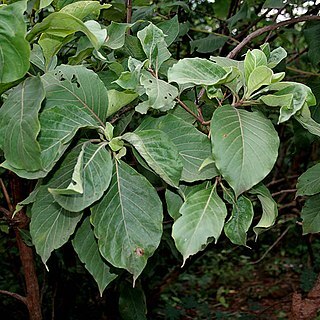Trees, shrubs or sometimes epiphytic, rarely lianes. Leaves opposite, petiolate, deciduous, often with domatia in the nerve-axils; stipules interpetiolar, entire or glandular-serrate, deciduous. Inflorescences mostly elongate, spicate or capitate, often with a pair of conspicuous petiolate leafy reticulate bracts at the base; spikes composed of numerous 1–3-flowered cymes in the axils of minute or moderate-sized secondary bracts. Calyx-tube ovoid or subglobose, the limb divided into 5(–6) elongate-subulate deciduous lobes. Corolla funnel-shaped or narrowly campanulate, the tube and throat glabrous within; lobes 5, valvate, short, erect. Stamens 5, inserted below the throat, included in the tube; filaments short; anthers basifixed, 2-thecous. Ovary 2-locular; ovules numerous in each locule, imbricate on cylindrical ascending placentas attached to the septum; style slender, long-exserted; stigma fusiform or ellipsoid, obscurely 2-lobed, acting as a pollen-carrier. Fruits capsular, oblong or subcylindric, 2-locular, the valves sulcate, dehiscing loculicidally into 2 valves, many-seeded, the placentas thin, finally free. Seeds ascending, imbricate; testa membranous, broadly winged, ± lacerate, the wing elongated, bifid at the hilar end; embryo small, the cotyledons oblong or round; radicle clavate or terete.
Ovary 2-locular; ovules numerous in each loculus, imbricate on cylindrical ascending placentas attached to the septum; style slender, long exserted; pollen presenter fusiform or ellipsoid, obscurely 2-lobed, receptive area restricted to distal part.
Inflorescences terminal, mostly elongate, spicate or capitate often with a pair of conspicuous petiolate leafy reticulate bracts at the base; spikes composed of numerous 1–3-flowered cymes in the axils of minute or moderate sized secondary bracts.
Seeds ascending, imbricate; testa membranous, broadly winged, ± lacerate, the wing elongated, bifid at the hilar end; embryo small, the cotyledons oblong or round; radicle clavate or terete.
Fruits capsular, lenticellate, oblong or subcylindric, 2-locular, the valves sulcate, dehiscing loculicidally into 2 valves, many-seeded, the placentas thin, finally free.
Corolla funnel-shaped or narrowly campanulate, the tube and throat glabrous within; lobes 4–5, valvate, short, erect.
Stamens 5, inserted below the throat, included in the tube; filaments short; anthers basifixed, 2-thecous.
Calyx tube ovoid or subglobose, the limb divided into 5(6) elongate-subulate deciduous lobes.
Leaves opposite, petiolate, deciduous, often with domatia in the nerve axils.
Trees, shrubs or sometimes epiphytic, rarely lianes.
Stipules entire or glandular-serrate, deciduous.

